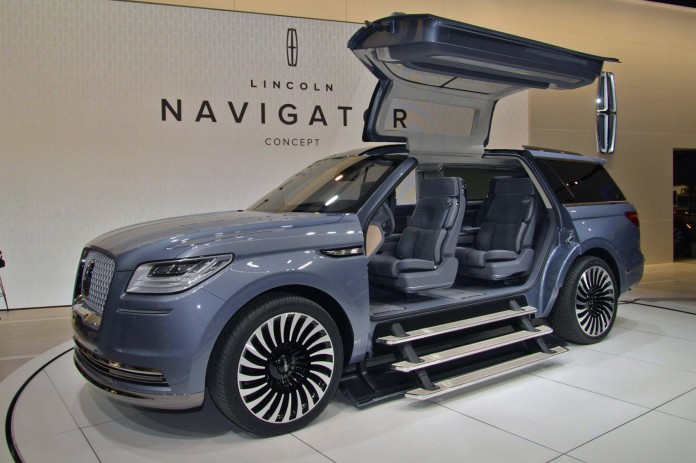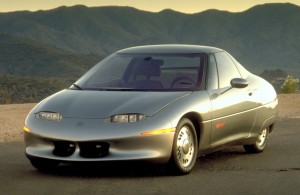
In this Monster Truck Nation, Detroit is still peddling the perverse illusion of ever-bigger ‘bad ass’ American luxury tanks as our teeming roadways implode
By Mark Cromer
Ours is an era of size-envy.
From garish homes posing as mansions built out to property lines to televisions-turned-theaters to hotel rooms displaced by ever more lavish suites to the almighty Big Gulp forsaken for buckets served up at the soda troughs, the American credo of ‘bigger is better’ still knows no more potent symbol than the vehicles on our crumbling roads.
The Chevrolet Suburban may have first debuted in the mid-1930s throes of the Great Depression, but it wasn’t until the 1970s—just in time for the OPEC oil embargo—that the beast that would define something called a ‘sport utility vehicle’ really began to take shape as the 12-miles-a-gallon monster that’s genetically recognizable on the road today.
According to a study published by the Oak Ridge National Laboratory, a national science and technology center in Tennessee that’s operated by the United States Department of Energy, by the 1990s the SUV became the fastest growing segment of the domestic auto industry. Far from a fad, the analysts at Oak Ridge determined the explosion of the oversize vehicle market “seems to indicate a permanent trend.” With more than 3 million SUVs rolling onto American roads annually by 2001, the report concluded “automobiles and SUVs will be sharing the highways for years to come.”
But even the smartest guys in the room couldn’t have truly grasped what was actually on the horizon.
The direct descendants of the Suburban, the GMC Yukon and the Cadillac Escalade, as well as rival Ford’s three-ton contribution to the luxury armored personnel carrier market, the Expedition, along with the less disguised Hummer H2, poured off the assembly lines at a pace not seen since World War II’s armaments factories cranked out Flying Fortresses to send American greetings to Berlin, Rome and Tokyo and SUVs are more ubiquitous today throughout traffic-choked Southern California and mass population centers throughout the United States than our bombers ever were over the skies of the enemy Axis capitals. It’s only far off the paved roads and into the wild lands, ostensibly where these vehicles were designed to actually operate, where they thankfully seem to be rarely if ever seen, lest their owners risk scratching them, let alone busting an axle.
Nothing says ‘into the wild’ quite like tri-zone climate control, cruise control, eight-way powered front seats, dual memory systems and BOSE premium sound systems that come standard with the Hummer H2.
But if the SUV fleets aren’t packing enough heat for your tastes, well that’s why the Motor City gods bestowed upon us the pickup truck of today, which are seemingly less about moving things and more designed for carrying you and towing everything you own into the apocalypse. The Ford F-150, F-250, F-350 and F-450 and whatever other variant the marketing boys cook up (the F-150 SVT Raptor, etc.) along with the Dodge Ram 3500 and the Chevrolet Silverado, are all tributes to the ravenous desire for more and bigger—and then more still. And then bigger again.
And thus Lincoln has unveiled its concept for the next gen Navigator, which is being described as a “land yacht” that the company says blends “elegance, beauty, serenity and harmony” while still remaining suitably “imposing.” Debuted at the New York Auto Show last month, Lincoln CEO Kumar Galhotra told trade reporters that the wheeled pleasure boat was “a very interesting challenge for the design team…to take a vehicle that has that much volume and to make it elegant is a fun challenge.” As with all things today, the new Navigator concept in jammed with enough multimedia high-tech so that while speeding through the food shortage riots of the near future occupants won’t be bored as each passenger station is equipped with large interlinked game screens. And yes, there is a cabin intercom system.
Galhotra apparently wasn’t asked about fire stations and weapon systems that come standard as well as up-armor options.
And apparently no one is talking about practical things like, oh, parking at the neighborhood market whose car stalls are the size of shopping baskets.
But if a shrinking, choking planet running on fumes hasn’t set off the idiot lights on Detroit’s dashboard by now they probably never will, and micro parking spaces is a small beer compared to the 11-miles-per-gallon of fuel these rolling Titanics suck up.
Just a generation ago in 1996, General Motors rolled out a commercial that announced the arrival of a car that was as revolutionary as Apple’s debut of a home computer called the Macintosh a generation before had been. The minute-long television spot featured a blustery night with lightening in the air and as the wind whirled, electrical outlets up and down a residential block in Any Town, USA, began to stir and chirp and beep as they came to life and made their way out of the homes and down to the sidewalk, lining it in anticipation.
The headlights appeared first, glimmering in the distance, and then a sleek, compact frame slipped silently down the street to stop amid the crowd of appliances gathering around it.
And with that, a human voice uttered five simple words: “The electric car is here.”

The EV1. Compact, clean, responsible, and yes, cool.
And then it was gone in 60-seconds, as GM turned off the groundbreaking vehicle it never actually sold to drivers, but only leased to them. The auto giant pulled the plug on the clean energy car in 2000 and in 2003 recalled its tiny fleet of operating vehicles (approximately 1,100 of the cars had been built) and then literally crushed them.
Thirteen years down the road and the question isn’t so much who killed the electric car, for they are not dead, but rather who killed the reasonable vehicle? In the long wake of the EV1 came Tesla and the Chevy Volt and the Nissan Leaf and other zero emission vehicles, but the assembly lines in America and around the world still churn out ever more massive vehicles that obscenely pander to every short-dicked Little Caesar over compensating for his desire to be Johnny Wadd and the soccer mom maidens who want to ride a Big One in style.
Sport utility, indeed.
In 2015, CNN Money heralded SUVs as ‘Kings of the Road Once Again’ and a Bloomberg analysis of the numbers bear them out: with sales of oversize trucks like Chevy’s Silverado and the Dodge Ram posting double-digit sales increases (with annual sales numbering more than a million vehicles of just those two lines alone in 2014) while more economic and reasonable vehicles like the Ford Fusion seeing a piddling sales increase of two-percent, or 300,000 cars sold in the same year.
The nation that once blended California cool and reason and social responsibility all wrapped in the fabled Ford 1965 Mustang is no longer behind that wheel.
This did not happen overnight.
America’s audacity has genetic roots dating to the Revolution when we told King George and the most powerful empire then on the planet to come and get it, but it has been running ever hotter in our blood since the rise of our own empire amid the Allied triumph in World War II, which saw not only the Axis powers crushed but Allied partners like Britain and France, millennial imperial powers that had long run the board, suddenly shunted into the backseat of a Western car driven by the Americans in a mean game of global chicken with our Russian frenemies.
A nd so began the advent of the brash American, the ever louder American, as the once agrarian republic devolved into industrialized Imperial America with her standard-bearer: the infamous ‘Ugly American,’ witnessed increasingly around the globe frequently a brawling drunk sporting a Hawaiian shirt. And with it came the rise of consumer America and the long cultural slide into the collective assessment that bigger and more imposing was intrinsically better, a shift that paralleled the Pentagon’s weapons procurement programs for a half-century.
But now John & Jane Q. American of every social strata are pacing the Joint Chiefs on a relative scale, demanding ever more and getting it. The infamous if mercurial $200 hammers the military reportedly paid for are now put to shame by the $500 ‘phones’ Americans work behind the wheel of their $50,000 ‘pimp-my-tank’ rides they procured with financing that makes the Pentagon’s budget look straightforward.
And so Lincoln’s concept Navigator unveiled in The Big Apple’s auto show last month is only the latest iteration of more rolling behemoths to come, and come again. Come what may.
And come what most certainly will: an undisturbed ride all the way to our planetary boneyard.
Who killed the reasonable vehicle? We did. Smiling.










